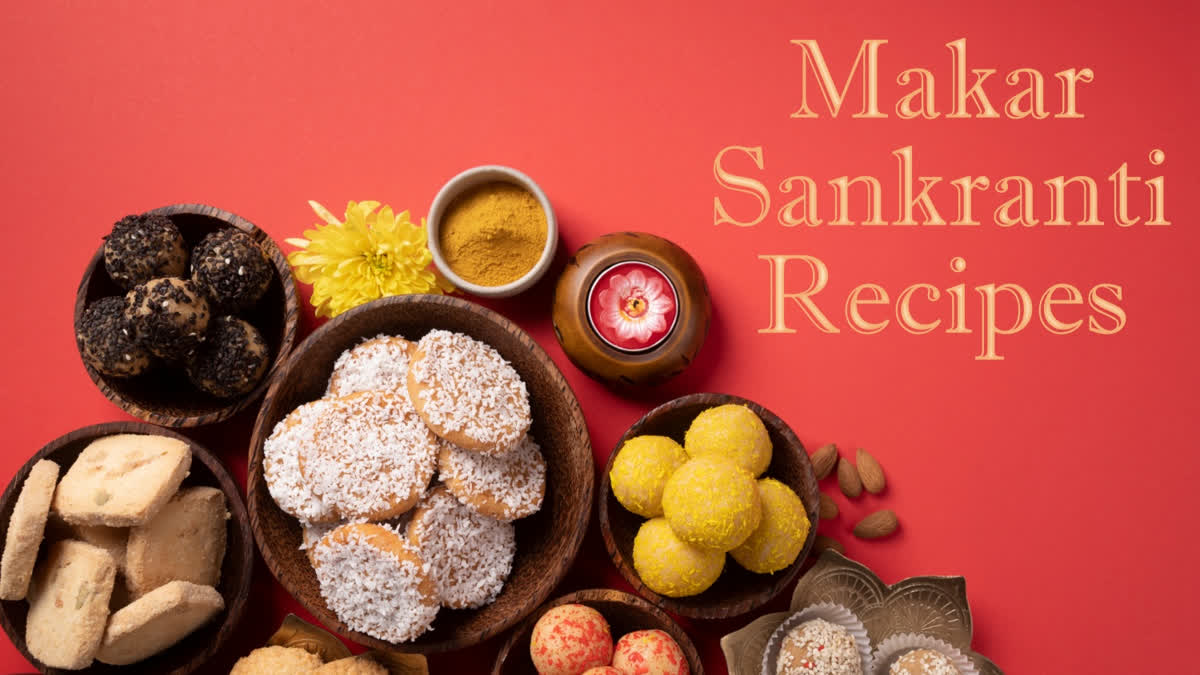No celebration of Makar Sankranti is complete without traditional sweet dishes cooked specially for the festival. In kitchens across India, as pots simmer and rice steams, we find that the harvest festival speaks the love language of food. In Punjab, the fiery festival of Lohri (celebrated the night before Sankranti) brings with it til (sesame) and rewari (jaggery sweets).
Enjoy cooking and savouring these delights.
1. Tilgul Ladoo from Maharashtra
In Maharashtra, Sankranti is unthinkable without Tilgul Ladoos, delicate orbs made from sesame seeds and jaggery. “Tilgul ghya, goad goad bola,” they say, handing over these sweets as tokens of goodwill, urging one another to speak only sweet words. The nuttiness of sesame mingles with the deep, caramelized embrace of jaggery, speaking of warmth in winter’s grip.
Ingredients:
- Sesame seeds: 1 cup
- Jaggery (grated): 1 cup
- Pure ghee: 1 tablespoon
- Cardamom powder: 1/2 teaspoon (optional)
Method:
- Dry roast the sesame seeds on low flame until they turn golden and aromatic. Set aside.
- Heat ghee in a pan and add the grated jaggery. Stir until the jaggery melts and becomes slightly frothy.
- Quickly mix the roasted sesame seeds into the jaggery and stir well.
- While the mixture is warm, shape it into small ladoos using hands greased with ghee.
- Let the til ladoos cool and store them in an airtight container.
2. Sweet Pongal from Tamil Nadu
Pongal is a dish that takes its name from the festival itself. The act of boiling rice, milk, and jaggery until they overflow symbolizes prosperity. Garnished with cashews, raisins and a touch of ghee, this sweet dish carries the earthy whispers of freshly harvested rice.
Ingredients:
- Rice: 1 cup
- Moong dal: 1/4 cup
- Jaggery: 1 cup
- Milk: 1 cup
- Water: 2 cups
- Ghee: 3 tablespoons
- Cashews: 10
- Raisins: 10
- Cardamom powder: 1/2 teaspoon
Method:
- Dry roast the moong dal lightly until aromatic. Wash and combine with rice.
- Cook the rice and dal mixture with water and milk until soft.
- Melt jaggery in a little water, strain impurities, and add to the cooked rice-dal mixture.
- Mix well and cook on low heat until the mixture thickens.
- Heat ghee, fry cashews and raisins, and add to the Pongal. Sprinkle cardamom powder and mix.
3. Paatishapta from Bengal
In Bengal, the air grows sweeter with the aroma of Paatishapta, delicate crepes made from rice flour and semolina, filled with a lush stuffing of coconut and jaggery or nolen gur. These soft rolls, often served with a drizzle of liquid jaggery, carry with them the blessings of the season.
Ingredients:
- Rice flour: 1 cup
- Semolina: 1/2 cup
- Milk: 2 cups
- Grated coconut: 1 cup
- Jaggery: 1/2 cup
- Ghee: 1 tablespoon
Method:
- Prepare the batter by mixing rice flour, semolina, and milk until smooth. Rest for 15 minutes.
- Heat jaggery in a pan, add grated coconut, and cook until the mixture thickens.
- Heat a non-stick pan, pour a ladle of batter, and spread thinly like a crepe.
- Place the coconut-jaggery filling on one side of the crepe and roll it up to seal it.
- Serve warm or at room temperature.
Arisa Pitha and Makara Chaula from Odisha
From Odisha comes the golden-crusted Arisa Pitha, a deep-fried rice cake sweetened with jaggery. The crackle of hot oil, the aroma of ghee, and the crunch of the first bite are an invocation of joy. Odisha also celebrates with Makara Chaula, a dish of uncooked rice soaked and mixed with jaggery, milk, banana and grated coconut.
4. Arisa Pitha
Ingredients:
- Rice flour: 2 cups
- Jaggery: 1 cup
- Water: 1 cup
- Ghee: 1/2 cup
- Cardamom powder: 1/2 teaspoon
Method:
- Heat water with jaggery until it dissolves. Strain impurities and let it simmer until syrupy.
- Gradually add rice flour, stirring constantly, to form a smooth dough.
- Let the dough cool slightly and shape into small discs.
- Heat ghee in a deep pan and fry the discs until golden brown.
- Drain on paper towels and serve.
5. Makara Chaula
Ingredients:
- Raw rice: 1 cup
- Milk: 2 cups
- Jaggery: 1/2 cup
- Banana: 1, sliced
- Grated coconut: 1/2 cup
Method:
- Wash and soak raw rice for a few hours. Drain well.
- Combine rice with milk, jaggery, banana slices, and grated coconut.
- Serve as a no-cook, sweet offering during the festival.
Read more:



